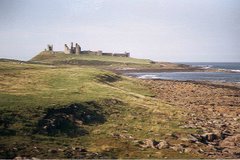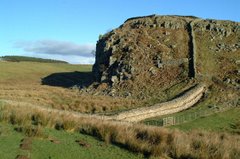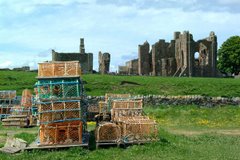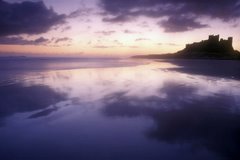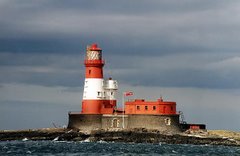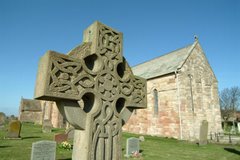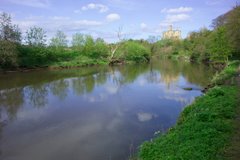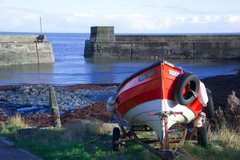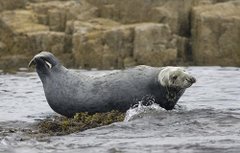Ford and Etal
Ford is a small village in Northumberland, England, about 13 miles (21 km) from Berwick-upon-Tweed. Ford shares a parish with Etal.
Very little is known of the history of the area before the Norman Conquest in the 11th century, but Bronze Age rock carvings in the area suggest that there might have been some settlement at that time.
It is thought the shallow crossing of the River Till (a ford) which gave the village its name, was probably a crossing place for monks and nuns travelling between the monasteries at Iona and Lindisfarne during the Anglo-Saxon period.
Written records for Ford begin after the Norman Conquest in 1066 and the introduction of the manorial system, when the manor of Ford was held by the Heron family. A substantial stone castle was built at Ford in 1287, in order to protect the Manor from the constant border warfare waged between the Scots and the English during the medieval period.
In 1513, James IV of Scotland made his base at Ford Castle, prior to the Battle of Flodden, the last major battle between the two nations. James was killed, along with 9,000 of his men.
After Flodden, peace came to the area and by the 19th century Ford was a thriving agricultural and forestry community. Ford Castle had been rebuilt in the 1760s and in 1859, Louisa, Marchioness of Beresford inherited Ford Estate on the death of her husband, the 3rd Marquess (who in turn, had inherited it from his mother, Susanna, Marchioness of Waterford). Lady Waterford, a gifted amateur watercolourist with an interest in the welfare of the tenants on the estate, rebuilt the village. A new school was built – today the Lady Waterford Hall, and is decorated with wall paintings by Lady Waterford, and opens daily at 10.30am. The 12th century church of St Michael's was restored.
The estate was bought by the Joicey family in 1907 and it remains in their ownership today. The castle was used as a convalescent hospital by the Red Cross during the Second World War and is now leased by the Northumberland County Council who use it as an educational camp. The castle is not open to the public except on open days.
Much of the employment in Ford is connected in one way or another with the Ford estate. There is St Michael's Church of England First School and a village shop, which doubles as a Post Office. There are also a number of businesses connected with tourism, such as Ford Nurseries, a second-hand book dealer and The Estate House, the local bed and breakfast.
Etal is a small village in the far north of the county of Northumberland, England which shares a parish with nearby Ford. It lies on a bridging point of the River Till ten miles south west of Berwick Upon Tweed, and can boast the substantial ruins of a medieval castle currently owned by English Heritage. It has just one residential street, and has a population of less than one hundred.
The village is centred on a now ruined castle, which over the years has seen much conflict between England and Scotland. The large majority of the buildings in the village are traditional and are owned by Ford & Etal estates. Also there is a thatched pub (The Black Bull) and nextdoor is the village hall. Hiding discreetly behind the Lavender Tearooms and a few more picture postcard houses is an expansive walled garden. Used extensively by the late Lady Joicey for the training of dressage horses, it is now used intermitintly for Icelandic Horse events and features a grass oval track.
Very little is known of the history of the area before the Norman Conquest in the 11th century, but Bronze Age rock carvings in the area suggest that there might have been some settlement at that time.
It is thought the shallow crossing of the River Till (a ford) which gave the village its name, was probably a crossing place for monks and nuns travelling between the monasteries at Iona and Lindisfarne during the Anglo-Saxon period.
Written records for Ford begin after the Norman Conquest in 1066 and the introduction of the manorial system, when the manor of Ford was held by the Heron family. A substantial stone castle was built at Ford in 1287, in order to protect the Manor from the constant border warfare waged between the Scots and the English during the medieval period.
In 1513, James IV of Scotland made his base at Ford Castle, prior to the Battle of Flodden, the last major battle between the two nations. James was killed, along with 9,000 of his men.
After Flodden, peace came to the area and by the 19th century Ford was a thriving agricultural and forestry community. Ford Castle had been rebuilt in the 1760s and in 1859, Louisa, Marchioness of Beresford inherited Ford Estate on the death of her husband, the 3rd Marquess (who in turn, had inherited it from his mother, Susanna, Marchioness of Waterford). Lady Waterford, a gifted amateur watercolourist with an interest in the welfare of the tenants on the estate, rebuilt the village. A new school was built – today the Lady Waterford Hall, and is decorated with wall paintings by Lady Waterford, and opens daily at 10.30am. The 12th century church of St Michael's was restored.
The estate was bought by the Joicey family in 1907 and it remains in their ownership today. The castle was used as a convalescent hospital by the Red Cross during the Second World War and is now leased by the Northumberland County Council who use it as an educational camp. The castle is not open to the public except on open days.
Much of the employment in Ford is connected in one way or another with the Ford estate. There is St Michael's Church of England First School and a village shop, which doubles as a Post Office. There are also a number of businesses connected with tourism, such as Ford Nurseries, a second-hand book dealer and The Estate House, the local bed and breakfast.
Etal is a small village in the far north of the county of Northumberland, England which shares a parish with nearby Ford. It lies on a bridging point of the River Till ten miles south west of Berwick Upon Tweed, and can boast the substantial ruins of a medieval castle currently owned by English Heritage. It has just one residential street, and has a population of less than one hundred.
The village is centred on a now ruined castle, which over the years has seen much conflict between England and Scotland. The large majority of the buildings in the village are traditional and are owned by Ford & Etal estates. Also there is a thatched pub (The Black Bull) and nextdoor is the village hall. Hiding discreetly behind the Lavender Tearooms and a few more picture postcard houses is an expansive walled garden. Used extensively by the late Lady Joicey for the training of dressage horses, it is now used intermitintly for Icelandic Horse events and features a grass oval track.
Article adapted from the Wikipedia online encyclopedia.
How to get to Ford and Etal:
By road from the south: take the main A1 trunk road north and turn left on to the A697. Follow the A697 northwards through Wooler. About 9 miles after Wooler turn right on to the B6353. Ford is about 2 miles east on the B6353.
By road from the north: Take the main A1 trunk road from Edinburgh and Berwick upon Tweed. About 3 miles south of Berwick, just past Scremerston, turn right on to the B6525. About 6 miles further on you will come to Barmoor Lane End, where the B6525 takes a sharp right and then left. Just after the sharp left take the B6353, which is the firt turn on the right.
By rail: The nearest station is Berwick upon Tweed.
By bus: There are no regular bus services to Ford and Etal.
Map of area: CLICK HERE


